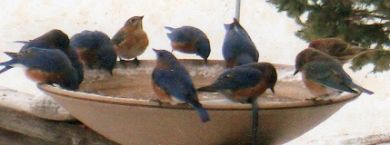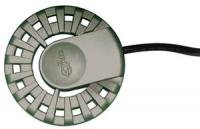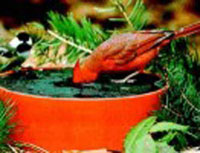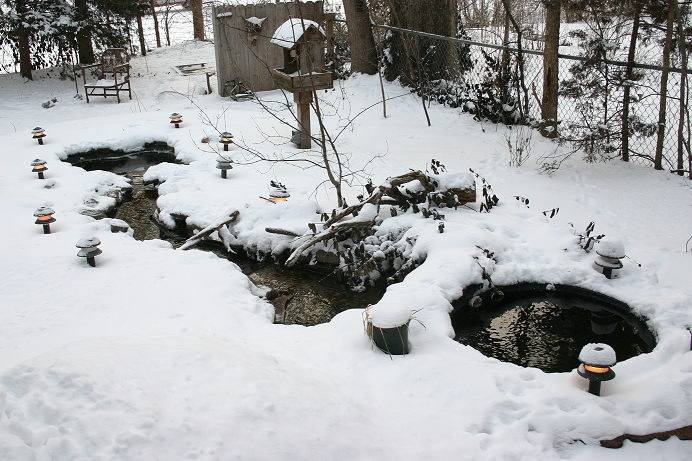Newsletters
Water For Birds In Winter Is Important
Temperatures have definitely been falling in the northern states and Central Great Plains as winter approaches. Even many southern states have experienced some cooler weather than normal. As the mercury drops it becomes increasingly more difficult for birds to find open water. In some areas a mid-day sun may melt enough snow to fulfill a birds requirement for water, but there is no guarantee of this as the icy grip of winter slowly sets in on the Plains and elsewhere.
During the winter, birds survive through the night on the energy from the foods they consume throughout the daylight hours. With little or no body fat, birds do not have the ability to store energy reserves as mammals do. Chickadees, which weigh ¾ of an ounce, the equivalent of three pennies in your palm, have developed a unique adaptation for conserving energy. On cold winter nights, Chickadees reduce their body temperature by as much as 18-22 °F from their normal temperature of about 108 °F to conserve energy. Such a capacity called torpor is rare in birds
The dilemma for birds becomes a matter of choice. They can fly a considerable distance to locate open water, expending valuable energy needed to get through a cold winter night, or they can eat snow, which lowers their body temperature requiring more food to raise attain peak energy levels.
What can the backyard birder do to help? Provide a daily source of open water for the birds visiting your backyard. The old saying is “You can attract more birds with open water in winter than you can with bird seed alone.” There are several ways to do this.
When using a heated bird bath, bird bath heater, or de-icer, keep in mind they all require electricity. An extension cord is usually required. Make certain to use only an outdoor approved extension cord and avoid excessively long cords as they may affect the function of the heater. These appliances have been approved by the Underwriters Laboratory and are safe to use and are safe for the birds. When it comes to the four components of habitat required for sustaining life; food, water, shelter, space, it is water that becomes a rare commodity for birds and other wildlife during the cold winter months.
- Heated Bird Baths: There are several bird baths on the market with built-in thermostatically controlled heaters which provide the most convenience for providing water in winter. They come with a multiple year warranty and do a good job keeping a large area of open water for the birds.
- Bird Bath De-Icers: De-icers are thermostatically controlled and keep the bath ice free down to zero degrees. In
 extreme sub-zero temps de-icers continue to provide an open area of water for the birds. Use in concrete, plastic, and metal bird baths
extreme sub-zero temps de-icers continue to provide an open area of water for the birds. Use in concrete, plastic, and metal bird baths
- Solar Sippers: A self contained bowl with a lid that has a small opening which allow birds access to the water. The construction is much like a coffee thermos with an air pocket between the outer structure and the inner bowl
 providing insulation. Since it relies on solar energy, it is brought in the house at night and placed back outside during the day. Although it requires no electrical energy, it will keep an open water source down to approximately 15 degrees.
providing insulation. Since it relies on solar energy, it is brought in the house at night and placed back outside during the day. Although it requires no electrical energy, it will keep an open water source down to approximately 15 degrees.
- Avian Ponds: Not exactly the season to install, but avian ponds with a meandering stream bed are probably the best year round fresh water source you can provide. With a heater placed in the reservoir it will continue to flow, even over several waterfalls, at temperatures well below zero. ( Photo left is Dave’s avian pond., an upper and lower reservoir connected, by a 16 foot bird creek with two small waterfalls. This avian pond operates even at –30 degrees

